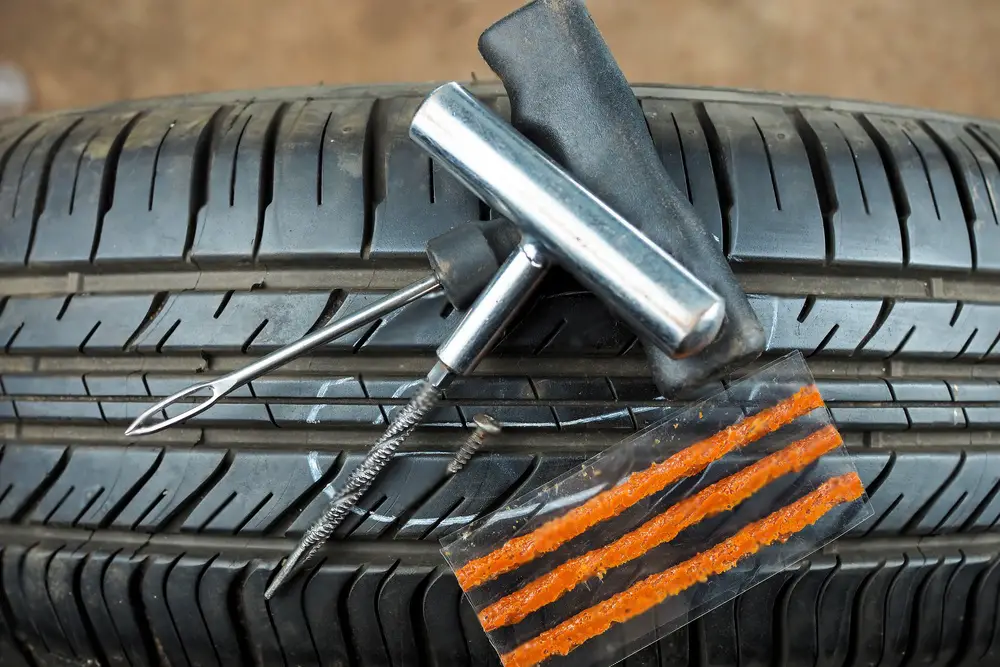A tire plug can be a permanent fix for small punctures in the tread area, but it’s not suitable for sidewall damage or large holes. For added safety and durability, combining a plug with a patch is recommended.
When a tire gets punctured, it’s natural to wonder if a simple repair, like plugging, can make it roadworthy again. Tire plugs are a popular quick-fix solution, but questions remain about their durability and safety. In this detailed blog, we’ll explore what tire plugs are, how they work, their pros and cons, and whether they can be considered a permanent fix. We’ll also address FAQs to help you make an informed decision about repairing your tire.

Contents
What Is a Tire Plug?
A tire plug is a piece of sticky, rubber-like material inserted into a puncture to seal it from the inside out. It’s a common method for fixing small punctures caused by nails, screws, or other sharp objects. The repair process involves:
- Removing the object causing the puncture.
- Cleaning the hole with a reaming tool.
- Inserting the plug into the puncture using a special tool.
- Trimming the excess plug material flush with the tire surface.
Is A Tire Plug A Permanent Fix?
The answer depends on several factors, including the location, size, and angle of the puncture, as well as the condition of the tire. Let’s examine these factors:
1. Location of the Puncture
The location of the puncture plays a critical role in determining whether a tire plug can serve as a reliable fix.
- Safe Areas: Tire plugs are generally effective for punctures in the tread area. This is the part of the tire that makes contact with the road.
- Unsafe Areas: Punctures in the sidewall or shoulder are not suitable for plugging. These areas endure significant stress, making plugs less reliable and potentially dangerous.
2. Size and Angle of the Puncture
The size and angle of the puncture are crucial factors in determining whether a tire plug is an appropriate solution:
- Small, Straight Punctures: A plug can be a reliable solution for small holes (less than 1/4 inch in diameter) that penetrate at a straight angle.
- Large or Irregular Punctures: Larger or irregularly shaped holes may require additional reinforcement, such as a patch or a plug-patch combination.
3. Tire Condition
The condition of the tire significantly impacts the effectiveness and safety of a repair:
- Good Condition: Plugs work best in tires that are otherwise in good condition, with no significant wear, cracks, or damage.
- Damaged Tires: Tires with extensive damage or multiple punctures are unsafe to repair and should be replaced.

Advantages of Tire Plugs
Tire plugs are a popular and convenient solution for repairing punctures in tires, particularly for small holes caused by nails, screws, or other sharp objects. Here are the key advantages of using tire plugs:
- Quick and Convenient: Plugging a tire is a relatively simple process that can be done in minutes.
- Cost-Effective: Plugs are inexpensive compared to replacing a tire.
- Temporary Mobility: A plug can get you back on the road quickly, especially in emergencies.
Disadvantages of Tire Plugs
While tire plugs are a convenient solution for minor punctures, they come with limitations and potential drawbacks. Here are the main disadvantages of tire plugs:
- Not Suitable for All Punctures: They are ineffective for sidewall damage or large punctures.
- Limited Longevity: While plugs can last a long time in some cases, they are not always as durable as other repair methods.
- Potential Safety Risks: Improper installation or using plugs in unsuitable areas can lead to tire failure.
When Is a Plug Not Enough?
While tire plugs can effectively repair small punctures in specific situations, there are instances where they are not sufficient. Knowing these limitations is crucial for maintaining safety and ensuring your tire performs reliably. Here are the situations where a plug is not enough:
1. Use a Plug-Patch Combination
A plug-patch combination, applied from the inside of the tire, is often considered the safest and most permanent repair method. This approach seals the puncture and reinforces the tire’s inner lining.
2. Replace the Tire
If the damage is too severe or located in an unsafe area, replacing the tire is the best option. Driving on a compromised tire risks blowouts, accidents, and further damage to your vehicle.
How Long Can a Plugged Tire Last?
A properly installed plug in a suitable area can last the lifetime of the tire, especially if the repair is reinforced with a patch. However, the longevity depends on factors such as driving conditions, tire pressure, and the size of the original puncture. Regular inspections are essential to ensure the plug remains secure.
Frequently Asked Questions
Here are some FAQs about plug tire –
1. Can a tire plug handle highway speeds?
Yes, a properly installed plug can handle highway speeds, but it’s safest when the repair is reinforced with a patch or inspected by a professional.
2. Is plugging a tire safe for long-term use?
A plug can be a long-term fix for small punctures in the tread area, but a plug-patch combination is more reliable for long-term safety.
3. Can I plug a run-flat tire?
Run-flat tires are designed to support limited driving after a puncture. While they can sometimes be repaired, many manufacturers recommend replacing them for safety.
4. How much does it cost to plug a tire?
DIY plug kits cost $10–$20, while professional repairs range from $25–$50, depending on the repair method.
5. Can I plug a tire more than once?
Multiple plugs in the same tire are not recommended, especially if they’re close together. In such cases, replacing the tire is safer.
Conclusion
While a tire plug can be a quick and effective solution for small, straight punctures in the tread area, it’s not always a permanent fix. For long-term safety and durability, a plug-patch combination installed by a professional is often the best choice. If the damage is severe or in an unsafe area, replacing the tire is the safest option. Always prioritize safety and consult a professional when in doubt about tire repairs.